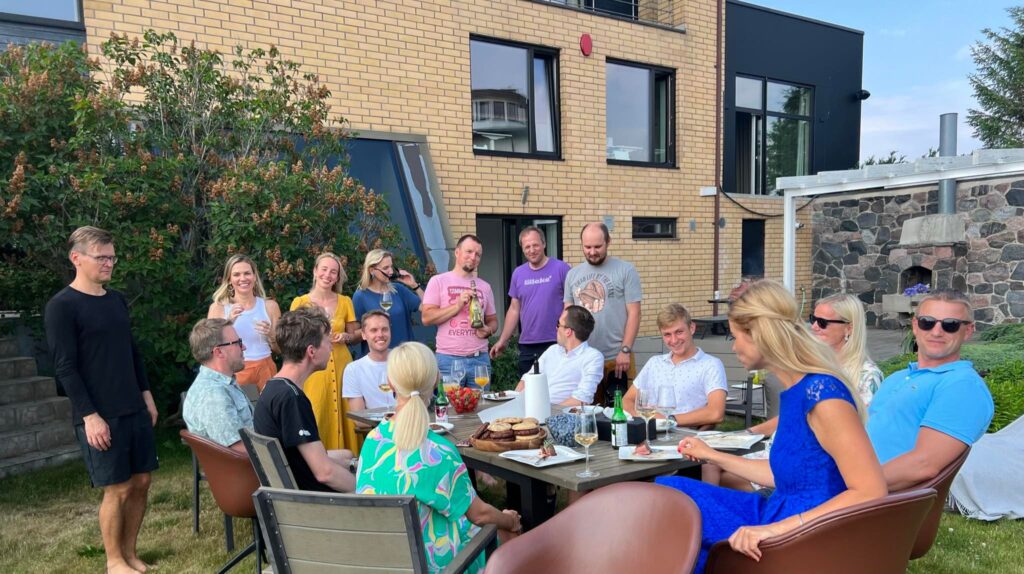This summer I joined the product marketing team of Estonia’s up and coming startup & Superangel portfolio company — KOOS (“together” in Estonian), a stakeholder incentivisation platform.
KOOS is founded by tech visionaries and backed by VCs like LocalGlobe and Plural VC, among other prominent angels like the CEO of Veriff and Bolt. They offer flexible, equity-like benefits to non-employee contributors of business growth, without the complexity or hassle of shareholder schemes. A new form of ownership likely to shape how businesses interact with their most valuable contributors.

As an advisor, first adopter, community member or a valuable supporter, you can develop almost like your own portfolio of companies that you’re proud to be part of and contribute towards:
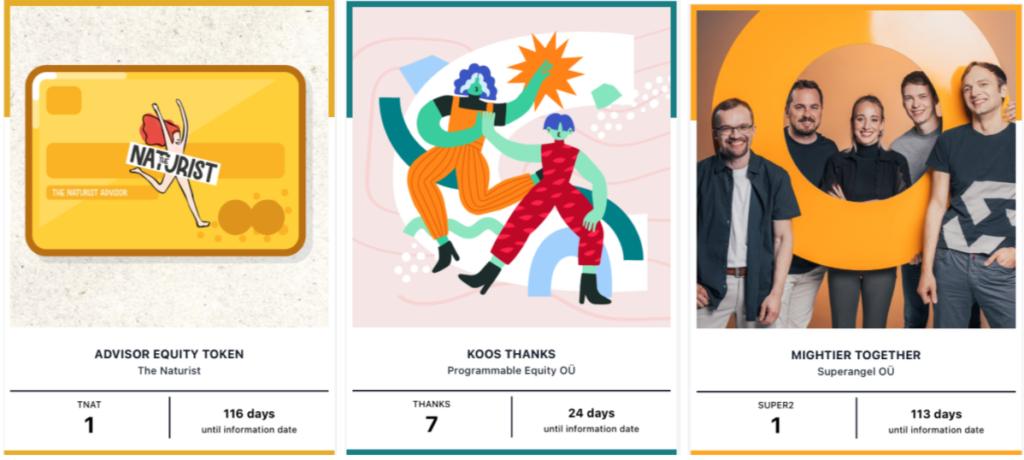
My main goal was to remind myself of the main challenges and opportunities that early-stage companies face. I spend a lot of time with many startups but I really wanted to deep-dive into one. By doing so, I can be more relevant to Superangel startups and rethink how we work with our teams. I achieved exactly that and I’m elaborating on the key challenges and good practices that I picked up from KOOS.
I Joined KOOS For 3 Main Reasons
🤝In addition to being an investor, Superangel is a client. That meant I got to develop our own strategy (we tokenised 5% of our carry) whilst providing feedback to KOOS team as a customer
👫 Epic team — KOOS was co-founded by Taavi Kotka, the first Chief Tech Officer (if you will) of the entire country, alongside several other serial entrepreneurs + domain experts
🏄🏼♀️ The trend that KOOS is riding on — a new form of ownership (i.e. engaging and rewarding the very people that drive business growth) & how the concept is leveraged by businesses is intriguing (more on that below)
*As a side note, the gender balance in the team is one of the best I’ve seen!
Becoming Relevant In Two-Months
I was most worried about whether two-months is enough to fully onboard to the company and start providing value. I know that as a small team, onboarding someone new takes a significant amount of time and effort. So I definitely felt the pressure to deliver.
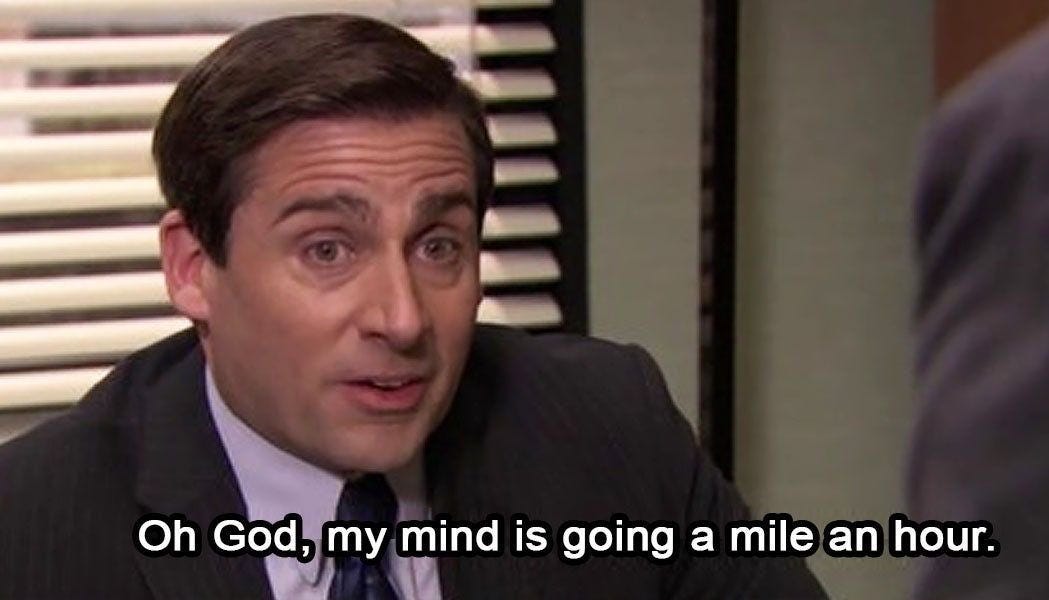
The first step of becoming relevant … was to sit and listen :’) I was a silent listener to all relevant meetings and also sat down with product marketing, customer support and sales teams individually to learn about their biggest challenges. I then went on to read the materials that the teams had put together for positioning, brand development, sales etc. Thanks to that I was able to get up to speed rather quickly. It can also be useful to reflect what you heard back to the team — a fresh perspective can go a long way.
Let’s Go Chat With Our Customers & Find Out All The Answers, Sounds Very Self-Explanatory
Two months flies by so quickly you can barely scratch the surface if there are no defined goals (ooh, isn’t this true with everything?!). So we set realistic (and somewhat measurable) goals and worked up from there. For example, we agreed that by the end of two months, I’d at least have interviewed 3–4 clients and drafted the first playbook of implementing the KOOS token program. It would serve as an input for putting together sales & onboarding collateral to minimise team’s input and empower clients to use the product the most impactful way. Easier said than done.
Here’s How It Went Down:
- I crafted customer interview scripts on Miro
- I defined three clear goals what I wanted to get from the interview
The goal of customer interviews was to map out all the challenges our clients faced so that we could provide better, proactive support. I also wanted to understand if there are smart hacks that they’re doing that could benefit others. Lastly, I wanted to clearly understand their use case and need for KOOS.
- Based on that I divided the interview into three core pillars with appropriate questions — must have & nice-to have questions (acknowledging that I might not have time to ask them all)
- Each pillar had their own context that I wrote down so I wouldn’t forget to add it during the interview rush
- I practiced it before with my team. Running smooth interviews is harder than it sounds. The key is to give A LOT OF context. I had to be reminded of this on several occasions because in my head I knew what I wanted to get out of it, but the customer didn’t. Therefore, during the interview I emphasised several times that the best result for me would be to map down as many problems as possible so the client wouldn’t feel they had to soften the truth.
- I asked permission to record the conversations so I could focus on running the conversations and listening rather than taking notes. After each interview, I listened it again, wrote detailed script and summarised it for other team members (I used Notion and Excel)
- I used the same conversations for client testimonials and social media content
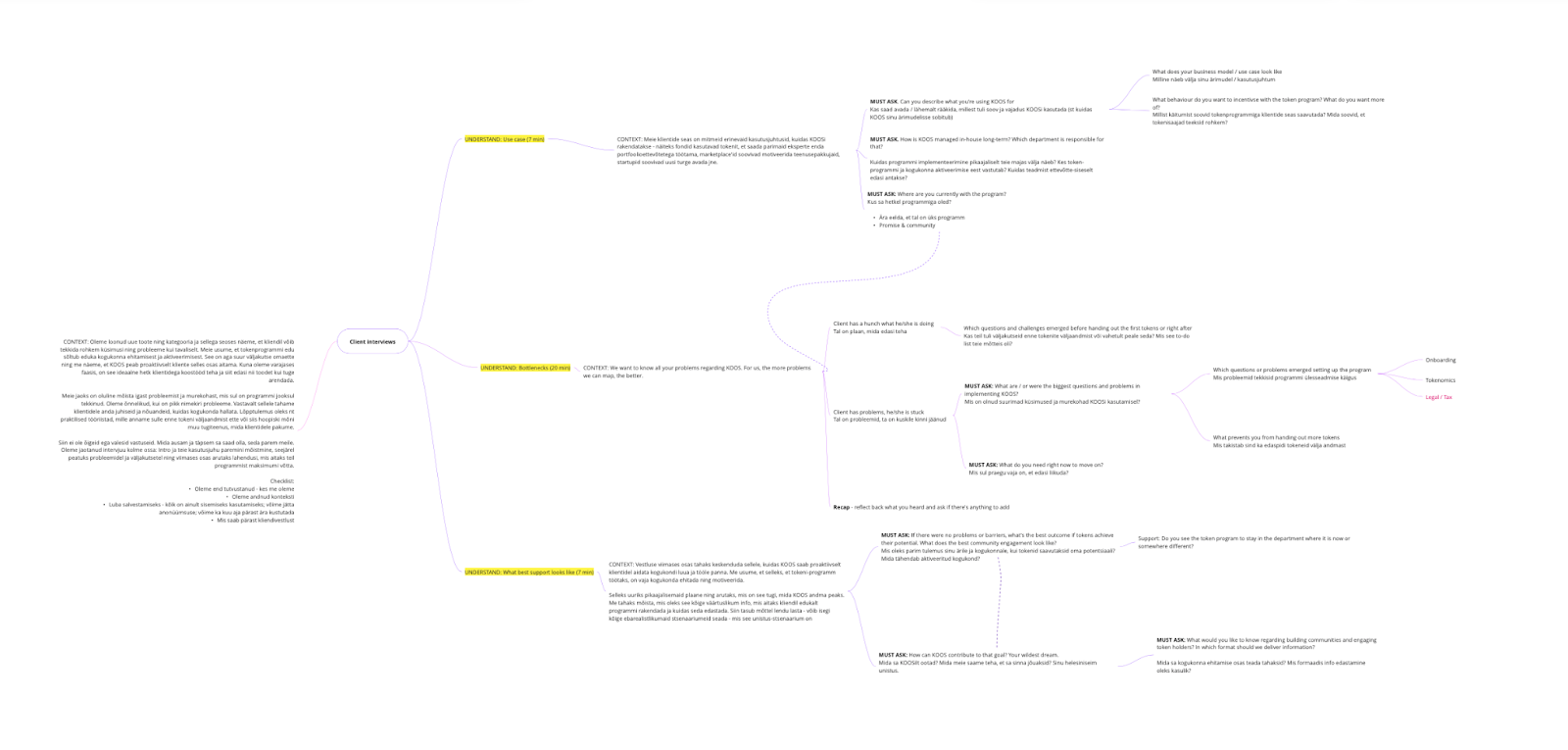
I’ve Got All This Knowledge Now, How To Make Sense Of It All?
In an ideal world, your clients all say the same thing and you know exactly what to focus on. The reality is probably different.
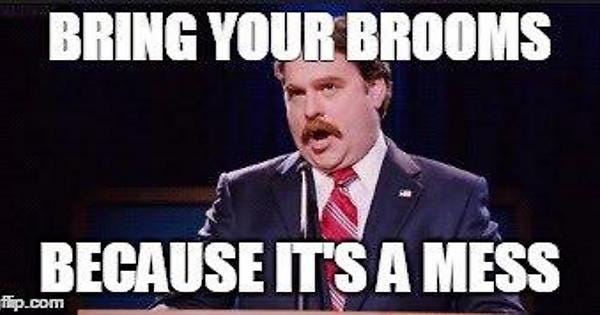
KOOS has many different customer profiles (marketplaces, startups, B2B) with varying use cases (referrals, community building, supply motivation). The resources and expertise that these teams have also varies, which means the level of support KOOS needs to provide differs.
It’s an ongoing process in which you just need to continue gathering data until there’s enough for pattern recognition. Maintaining an open mind and embracing that you don’t have rock hard truths at this moment is OK. You can, however, start forming loosely held hypotheses and use new data to either strengthen or lose them. That’s what we did. The product marketing team took the data I had gathered and formulated their initial thesis.
Anyyyyhow, from my conversations with clients, I started putting together a manual or a playbook of implementing the KOOS token system internally. I wrote down what I knew and didn’t know (it’s a messy document — I sent out my warnings before handing it over). For that, I also did some heavy research on communities, community-led businesses, shared ownership, tokenisation, marketing & brand development etc.
Here Are Some Good Resources On Tokenisation, Community Capitalism, Ownership Economy And Community Building
Shared ownership & tokenisation:
- Twitter thread on how a wellness app (sweateconomy.com) uses tokenisation to grow 80% a year (this account in general is a good source of knowledge)
- One of the few reports on the Ownership Economy 2022, sharing how, for example, token incentivisation is used to boost user loyalty
- Study: Bumped: The Effects of Stock Ownership on Individual Spending demonstrating how weekly spending increased 100% for brands which individuals received stock
- Twitter: 35 business ideas of how web3 could improve or disrupt the most successful companies — i.e. how could shared ownership be leveraged today
Community capitalism & post-marketing era: Podcast & Blog — Discusses how Web3 affects marketing (i.e. — ads are not the future)
Community:
- The best playbook in my opinion on how to build community driven businesses: https://www.lennysnewsletter.com/p/building-community
- Masters of Community podcast
- Community-led businesses ABC — https://www.communityled.com (I was really surprised to learn that some of very prominent tech startups have pledged that community-driven businesses are the future)
Let’s Be A Bit Smarter Than Last Week
Aside from my own activities, I was fully immersed in the everyday life of a startup. It was refreshing to see what are the actual challenges from the inside rather than having the VC glasses on.
I think these challenges boil down to two main things: operations / communication and focus.
When things are so hectic — e.g. you’re hunting for your first customers whilst trying to understand who are the best ones, each week someone onboarding to the company, opening up new markets, figuring out positioning & messaging, launching a new website etc. — it can be challenging to ensure important topics don’t fall off the table and that information is equally available for everyone.
In an early phase like that it’s likely that you don’t have efficient processes set up for data collection & sharing, and communicating between the teams (or in the early stage, individuals). There are overlapping conversations and topics, combined with opinions and ad-hoc brainstormings. This creates noise and it’s not unusual to feel overwhelmed.
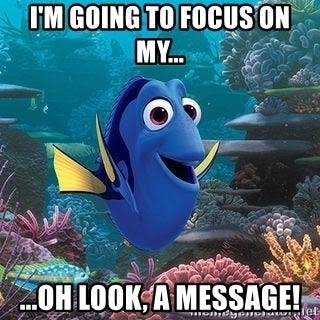
At this point, maintaining focus is the most important, and hardest, thing to do. Learning fast is of utmost importance, which is why you really have to choose your battles. The issue is not a lack of ideas, it’s saying no to most things (but not to the right things 😅).
It’s soooo easy to be drawn into a new thread of conversations and go down the rabbithole or start brainstorming ALL the good things that should be there or happen. OK… but let’s focus and come back to the thing that moves the needle the most, right now.
As Taavi put it, the goal is to be a bit smarter than last week.
Actually, We’ve Got This
This little chaos was okay for me because I fully trusted the team to figure it out. So here are the good practises that I really liked about how the team thought and worked.

- KOOS had done a really cool and relevant product positioning exercise that was the basis for the rest of the operations, be it marketing, sales or product development. Positioning is something that in my experience startups rarely think of, either because there’s a lack of data or awareness.
KOOS used https://www.g2.com to narrow down to 3 relevant categories but realised that with each of them they need to do more explaining why they’re different than to emphasise on their strengths. So category creation was the only way to go (and the way Pirjo did it was impressive but unfortunately not scalable to other startups — so try to find your own Pirjo 😜)
- The importance of brand development. Messaging, branding, informative web, social media and supportive materials are a must, especially if building a novel product. KOOS made a decision to invest in this by hiring external agencies and experts — you’ll soon enough see a result of that.
- Sales meetings were recorded and monitored in Pipedrive. Each week, sales team showed stats on how they are doing and where each client is in the process. They tracked where the leads came from and how they were converting based on their origin. Sounds self-explanatory yet often basic operations like these can seem irrelevant, especially if the team is small and everyone works independently. Although, I should point out that in the early stages it’s also completely OK to focus on discovery and hence what you track can be different.
- Having a holistic overview of sales allowed other relevant teams to chip in and contribute. For example, each week product, product marketing, customer success and sales met to discuss interesting cases and main challenges. Typically we focussed on how product marketing can better support sales, the main questions that clients ask, which client profiles emerged and their use cases, and how to optimise sales processes. Having these people in one room once per week was a great way to align the teams and ensure the company was as customer-centric as possible.
- My favourite thing was the ‘Founder Hour’ (I took the liberty of naming it myself 😁). Each month Taavi gathered the whole team to share his vision of KOOS and the greatest opportunities / challenges that the team faces. This is the lowest hanging fruit that founders should do. Hearing the CEO of the company share his passion, enthusiasm and take on the company is super inspiring. Doing it often might feel like repetition but it isn’t, especially in a time where the team is growing and new people are settling in.
- Don’t get stuck doing everything yourself but ask for help. KOOS team involved several experts on tasks that either didn’t make sense to spend too much time on but were still necessary (e.g. content creation) or where figuring everything out would’ve been too time consuming and potentially costly (e.g. new market entry). This comes down to the focus point.
- ‘Why are we doing that?’ was a refreshing question that was asked more than once. And it wasn’t meant as a skeptical after-thought but more to ensure team members spent time on things with the most impact. It’s tempting to dive into the to-do list (that in a startup is never-ending) but zooming out to the big picture is a good way to reset.
- ‘Who’s accountable for that?’ falls exactly to the same category as the previous point. Don’t finish off a discussion without agreeing who will go forward with that.
I took a lot from only two months and came back with a much clearer understanding of what we as VCs can do to help support companies like these on a very fast-moving journey.
Thanks KOOS for being so welcoming & fun to work with! Now go and talk to their team how your business could accelerate growth through stakeholder incentivisation!
